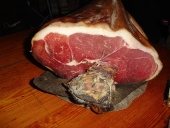




A pint of white wine or wine and water mixed
a large handful of almonds (I used raw)
Honey to taste (or for vegan version, a different liquid sweetener)
Poudre Forte or you could just use cinnamon and/or nutmeg mixed.
Bring the wine to a boil, take off the heat and add almonds, about half a teaspoon of honey, and a generous pinch of spice. Leave to steep for an hour or so to cool. Take the almonds out (keep the liquid) and smash them well. Mortar and pestle is fine or use the Blitzer. The aim is a fine mush. Add the liquid back to the almonds and pound or mash again - this is the tricky part for me. apparently, my Blitzer does not fit a full pint of liquid and makes a huge mess all over the kitchen when I ask it to try just this once. Also, the blades aren't sharp enough to mash the almonds fine enough. So I did about half way in the Blitzer then transferred small batches to work in the mortar. Strain the milk through a fine sieve or cheesecloth. Flavour with more honey and spices if needed, and sprinkle a few spices on top.











"You must be the change you want to see in the world." "First they ignore you, then they laugh at you, then they fight you, then you win." --Mahatma Gandhi
"Preach the Gospel always, and if necessary, use words." --Francis of Assisi.
"Family farms work when the whole family works the farm." -- Adam Klaus
 1
1















 1
1




Best luck: satisfaction
Greatest curse, greed




Thekla McDaniels wrote:I used to make almond milk. I did not want the pasteurized almonds for my milk. There is something tricky about "raw" almonds that have been pasteurized. I found this farm
http://www.organicalmondsraw.com/About_Us.html
my memory is that they are organic. In any case their almonds are high quality and unpasteurized. I bought 35 pounds or something like that. Including the shipping the cost was cheaper than the by the pound price at the "natural foods" market, and for a superior product.
Less packaging too. I used those almonds for more than a year. They did not spoil or get rancid




Best luck: satisfaction
Greatest curse, greed




 1
1




“The most important decision we make is whether we believe we live in a friendly or hostile universe.”― Albert Einstein




John Weiland wrote:Unless I use honey as a bit of sweetener, I find that almond milk goes bad a bit too quickly for my interest and was wondering about the following fix. Given that I mostly use it for coffee or in other small doses, can you make it rather thick and pour it into an ice tray to make "mylk cubes"? If this does not cause denaturation and curdling of the thickened milk due to freezing, I would consider using this as a way to extend the life of each batch of almond milk. Anyone know if this might work for "almond creamer"? Thanks!











r ranson wrote:
I'm curious how many almonds to water do you use? How long do you soak? I'm curious about other recipes in case there's a better way than I do it. I don't want to miss out.
“The most important decision we make is whether we believe we live in a friendly or hostile universe.”― Albert Einstein




John Weiland wrote:
So I will try blending some almonds today to the thicker cream and freezing it in ice cube trays and report back soon as to how it works, stores, ...... and does or does not curdle upon thawing.
“The most important decision we make is whether we believe we live in a friendly or hostile universe.”― Albert Einstein
















 2
2




Follow some of my adventures in writing here and pick up my cookbook/guide to radio drama Box 13 here
 1
1




















Follow some of my adventures in writing here and pick up my cookbook/guide to radio drama Box 13 here












|
Is that almond roca? Did you find it in the cat box? What is on this tiny ad?
The new purple deck of permaculture playing cards
https://www.kickstarter.com/projects/paulwheaton/garden-cards
|








